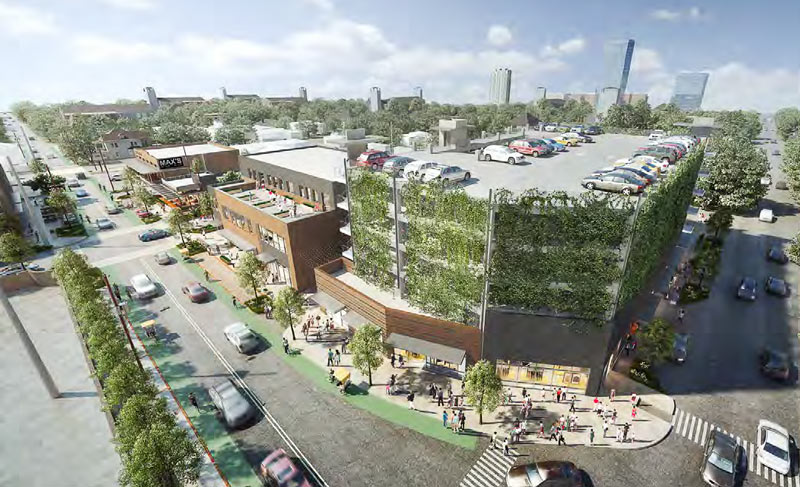HOW TO DESIGN A PARKING GARAGE THAT WON’T BECOME USELESS ONCE CARS GET RESTLESS  The best way to make sure parking garages don’t become obsolete heaps of concrete once cars figure out better things to do with their time when drivers aren’t using them is to build structures that have flat floorplates and more headroom, Gensler’s Peter Merwin tells reporter Kyle Hagerty: “Any future use will require level ground rather than the steep slopes typical to garages, so designing flat floors on every level is critical. To convert to residential, developers need a minimum 11-foot floor-to-floor height. That allows designers to properly core the infrastructure and build out the space.” Merwin, who works in Gensler’s Houston office, is guiding the design of the proposed Fairview District Garage at Fairview and Genesee streets in Montrose. His ideal future-proofing floor-to-floor dimension for garages as we approach the age of the driverless car? 15 ft. “That opens up the option to convert each floor into lofts, residential, retail or office. Another added benefit is that in the event you need more parking, not less, you can convert a 15-foot level into a double stacking parking floor like those in operation in many dense metros.” [Bisnow] Rendering of Fairview District Garage: Gensler
The best way to make sure parking garages don’t become obsolete heaps of concrete once cars figure out better things to do with their time when drivers aren’t using them is to build structures that have flat floorplates and more headroom, Gensler’s Peter Merwin tells reporter Kyle Hagerty: “Any future use will require level ground rather than the steep slopes typical to garages, so designing flat floors on every level is critical. To convert to residential, developers need a minimum 11-foot floor-to-floor height. That allows designers to properly core the infrastructure and build out the space.” Merwin, who works in Gensler’s Houston office, is guiding the design of the proposed Fairview District Garage at Fairview and Genesee streets in Montrose. His ideal future-proofing floor-to-floor dimension for garages as we approach the age of the driverless car? 15 ft. “That opens up the option to convert each floor into lofts, residential, retail or office. Another added benefit is that in the event you need more parking, not less, you can convert a 15-foot level into a double stacking parking floor like those in operation in many dense metros.” [Bisnow] Rendering of Fairview District Garage: Gensler





One word: delusional.
–
If cars become obsolete, so too does the downtown and city core area where so many parking garages exist. Think about it. Just build the garage and tear it down in 30 years if you need to. That’s the houston way.
Engineering specs and safety factors on parking garages are a heck of a lot different than for commercial property fit for human occupancy. This will be a very bulky and expensive parking garage, and if it has a ramp at all then it will have a significant degree of functional obsolescence to contend with in a conversion no matter what the future holds.
.
Take a step back and look at the problem. Many autonomous jitneys are mostly going to operate along a fixed route and won’t park except to swap a battery pack; but some will spend a lot of time parked, the same as METRO buses at the bus barn. These facilities will likely be quite a bit more decentralized, though. Autonomous taxis are likely to attract the ire of local/state regulation if they loiter too often in high-value parking spots or drive continuously around a given block waiting for a fare. I think that companies that offer either of these sorts of services will want small highly-efficient structured parking that bear some resemblance to a Carvana outlet and that provide almost no accommodation for human occupancy or use. To that end, flat floors and elevators probably make good sense, but high ceilings really do not.
.
For now, I think that if you’re going to build a parking garage, you should do it on its own merits. If you’re going to build commercial space, you should likewise do the same. It is a very rare case indeed where structures that are designed to be modular or mobile actually fulfill the purpose for which they were created.
to all the naysayers, it’s already being done in Atlanta.
http://inhabitat.com/scad-students-transform-an-atlanta-parking-garage-into-ecologically-responsible-micro-housing/
I think the live load requirements for a parking structure are actually a little higher than a residential building, but the bigger misconception is that shared autonomous cars don’t need to park. The fleet of autonomous cars will have to be sized to meet peak demand, which happens for a few hours in the morning and a few in the afternoon. Outside of those hours, a large proportion of the fleet will need to be stored somewhere.
Overnight, that somewhere can be a non-central location, since presumably many people will still live in suburbs. But during the day, surplus vehicles will be most efficiently stored somewhere close to where their passengers will be in the afternoon.
The real advantage is that the car storage won’t have to be so closely tied to the destination, so a parking structure every few blocks should be adequate, rather than each building needing its own dedicated (usually surface) parking. It’s more likely that this garage will stay a garage, but nearby surface lots can be developed into actual buildings.
the goal should be to move away from car dependency and not to continue to embrace it. cars have adulterated our minds and physical landscape so heavily that people literally cannot image life without it.We need smart development regulations that promote the way cities developed for 1000s of years, before cars. If the future is still “car” then I want nothing to do with it. #DitchYourCar
@ Angostura: Do you recall that parking garage that partially collapsed due to a car fire, and the insipid and totally pointless debate that followed on Swamplot regarding the melting point of structural steel and 9/11 conspiracies? Okay, well the structural engineers that contributed to that thread, whom were the voice of reason, mentioned that safety factors specified by codes vary based on the sort of occupancy that is anticipated for the structure. That may very well vary by City or even by engineering firm, of course.